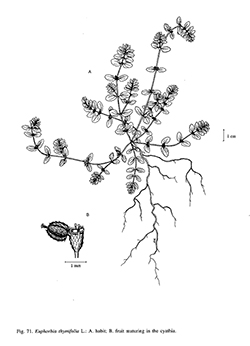e-Flora of Thailand
Volume 8 > Part 1 > Year 2005 > Page 286 > Euphorbiaceae > Euphorbia
20. Euphorbia thymifolia L.wfo-0000965105
Sp. Pl.: 454. 1753; Roxb., Fl. Ind. ed. 1832, 3: 473. 1832; Miq., Fl. Ind. Bat. 1, 2: 420. 1859; Boiss. in DC., Prodr. 15(2): 47. 1862; Hook.f., Fl. Brit. Ind. 5: 252. 1887; Craib, Bull. Misc. Inform. Kew 1911: 456. 1911; Contr. Fl. Siam: 182. 1912; Ridl., Fl. Malay Penins. 3: 182. 1924; Gagnep. in Lecomte, Fl. Indo-Chine 5: 246. 1925; Burkill, Dict. Econ. Prod. Malay Pen. 1: 980. 1935; M.R.Hend., Malay. Wild Fl.: 461, fig. 415 C. 1959; Backer & Bakh.f., Fl. Java 1: 503. 1964; Radcl.-Sm., Kew Bull. 26: 267. 1972; Whitmore, Tree Fl. Malaya 2: 96. 1973; P.H.Hô, Câyco Viêtnam 2, 1: 363, pl. 4679. 1992, p.p.; J.S.Ma, Fl. Reipubl. Popularis Sin. 44(3): 52, pl. 11 fig. 6–11. 1997.— Chamaesyce thymifolia (L.) Millsp., Publ. Field Mus. Nat. Hist Chicago, Bot. Ser. 2: 412. 1916. Fig. 71.
Accepted Name : This is currently accepted.
Description : Perennial, forming dense mats, up to 20 cm in diam. under trampling, otherwise partially erect and up to 10 cm high, branched at base, with some smaller side branches above; greyish green and usually reddish-purple tinged on all parts. Indumentum consisting of pale to creamish hairs, 0.2–0.7 mm long, appressed when short, loosely erect when longer, scattered but distinct on vegetative parts, on the stems often only above. Stipules 0.7–1.2 mm long, completely free and linear, sometimes slightly split. Leaves: petioles ca 0.5–1 mm long; opposite; blades broadly elliptic, the largest ones 4–7 by 3–5 mm, conspicuously smaller on side branches, base oblique with a cordate and an obtuse half, margin serrate, apex rounded, with scattered hairs above and below, distinctly brighter and hyaline-papillate below; triplinerved, additional side veins nearly invisible, ca 3-pairs. Cyathia grouped to few (ca 3) in axillary sessile clusters with several linear bracts; peduncle elongating to form small side branches few cm long with smaller leaves and apical cyathial clusters, distinctly pubescent; involucre ca 0.7–0.8 mm long, split by maturing fruit; glands 4, ca 0.1 mm wide, stipitate, purple, with transversely elliptic, narrow, ca 0.2 mm wide, pinkish appendages; ovary sessile, pubescent; stigmas ca 0.5–0.6 mm long, mostly bifid. Fruits with a pedicel of 0.3–0.4 mm (shorter than the involucre) and therefore maturing in the cyathium; schizocarp 0.9–1.0 by 0.9–1.0 mm, sulcate and hardly carinate, distinctly short-appressed pubescent allover. Seeds ca 0.8 by 0.4–0.5 mm, yellowish-brown, not papillate but with shallow, transverse furrows, ecarunculate.
Thailand : NORTHERN: Chiang Mai, Nan, Lamphun, Uttaradit, Tak, Nakhon Sawan; NORTH-EASTERN: Nong Khai, Kalasin, Khon Kaen; EASTERN: Chaiyaphum, Ubon Ratchathani; SOUTH-WESTERN: Kanchanaburi, Prachuap Khiri Khan; CENTRAL: Chai Nat, Phra Nakhon Si Ayutthaya, Saraburi, Krung Thep Maha Nakhon (Bangkok), Samut Prakan; SOUTH-EASTERN: Chachoengsao, Chon Buri; PENINSULAR: Phuket, Nakhon Si Thammarat, Phatthalung, Trang, Songkhla.
Distribution : Pantropical weed, origin and type locality uncertain.
Ecology : Weedy in plantations of rubber, soybean or other crops, lawns and gardens, on open grassy places, roadsides, pavements and car parking areas, often on places with heavy trampling and one of the few species surviving in cracks of roads, but also on sand dunes in beach forests; on sand or earth, limestone or granite bedrock; sea level up to 800 m alt. (outside of Thailand known from ca 2,000 m). Flowering and fruiting: the whole year through.
Vernacular : Nam nom ratchasi lek (น้ำนมราชสีห์เล็ก)(Central); no-chi-yong (นอเจียง)(Karen-Kanchanaburi).
Uses: In Arabia and Java the leaves are applied to skin complaints and wounds. Dried leaves and seeds are adstringent and used in India and Java against diarrhoea and dysentery by children.

